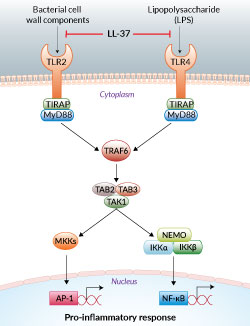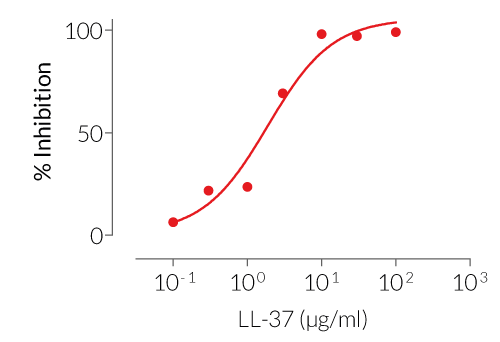LL-37
| Product | Unit size | Cat. code | Docs. | Qty. | Price | |
|---|---|---|---|---|---|---|
|
LL-37 Antimicrobial peptide - InvitroFit™ |
Show product |
1 mg 5 x 1 mg |
tlrl-l37
|
|
LL-37: Antimicrobial peptide

TLR2 and TLR4 inhibition by LL-37
LL-37, also known as hCAP18, is a synthetic peptide derived from the C-terminal region of the human cationic antimicrobial protein (hCAP). LL-37 exhibits a variety of immunomodulatory functions [1, 2]. Of note, it suppresses the inflammatory response induced by the activation of TLR2 and TLR4, which recognize different bacterial cell wall components [3].
Mode of action:
Due to its positive charge, LL-37 interacts with negatively charged cellular targets such as the bacterial lipids lipoteichoic acid (LTA) and lipopolysaccharide (LPS), hence, preventing these agonists from binding to their respective TLR receptors. In this way, LL-37 inhibits the activation of lipid-sensing TLRs [1].
LL-37 also targets DNA, RNA, and polyribosomes. Conversely, LL-37 enhances the activation of nucleic acid-sensing TLRs [1]. Specifically, LL-37 interacts directly with the negatively charged nucleic acids and protects them from degradation by DNases and RNases. Notably, LL-37 can enhance TLR3 signaling by interacting directly with double-stranded RNA (dsRNA), such as poly(I:C) [4]. Furthermore, LL-37 can form a complex with single-stranded RNA (ssRNA) [5] and with ssDNA [6] enhancing TLR7/TLR8 and TLR9 signaling, respectively.
In contrast, AIM2 inflammasome formation is inhibited by the LL-37:DNA complex through steric hindrance [7].
Key features:
- Inhibitor of TLR2- and TLR4-activation
- InvitroFit™ grade: each lot is highly pure (≥96%) and functionally tested
References:
1. Scheenstra M.R. et al., 2020. Cathelicidins modulate TLR-activation and inflammation. Front Immunol. 11:1137.
2. Scott A. et al., 2011. Evaluation of the ability of LL-37 to neutralise LPS in vitro and ex vivo. PLoS One. 6(10): e26525.
3. Di Nardo A. et al., 2007. Cathelicidin Antimicrobial Peptides Block Dendritic Cell TLR4 Activation and Allergic Contact Sensitization. J. Immunol.178: 1829 - 1834.
4. Lai Y. et al., 2011. LL37 and cationic peptides enhance TLR3 signaling by viral double-stranded RNAs. PLoS One. 6(10):e26632.
5. Ganguly D. et al., 2009. Self-RNA antimicrobial peptide complexes activate human dendritic cells through TLR7 and TLR8. J Exp Med. 206(9):1983-94.
6. Lande R. et al., 2007. Plasmacytoid dendritic cells sense self-DNA coupled with antimicrobial peptide. Nature. 449(7162):564-9.
7. Dombrowski Y. et al., 2011. Cytosolic DNA triggers inflammasome activation in keratinocytes in psoriatic lesions. Sci Transl Med. 3(82):82ra38.
Specifications
CAS number: 154947-66-7
Working concentration: 1 -50 µg/ml
Solubility: Water (1 mg/ml)
Amino acid sequence: LLGDFFRKSKEKIGKEFKRIVQRIKDFLRNLVPRTES
Molecular formula: C205H340N60O53
Molecular weight: 4493.37 g/mol
Quality control:
- Purity ≥ 96% (UHPLC)
- The inhibitory activity has been validated using cellular assays.
- The absence of bacterial contamination (e.g. lipoproteins and endotoxins) has been confirmed using HEK-Blue™ TLR2 and HEK-Blue™ TLR4 cells.
Contents
LL-37 is provided lyophilized and is available in two quantities:
- tlrl-l37: 1 mg
- tlrl-l37-5: 5 mg (5 x 1 mg)
- endotoxin-free water; 1.5 ml for tlrl-l37 and 10 ml for tlrl-l37-5
![]() LL-37 is shipped at room temperature.
LL-37 is shipped at room temperature.
![]() Upon receipt, store at -20°C. Upon resuspension, prepare aliquots and store at -20°C or -80°C.
Upon receipt, store at -20°C. Upon resuspension, prepare aliquots and store at -20°C or -80°C.
![]() The resuspended product is stable for 1 month at -20°C when properly stored. Avoid repeated freeze-thaw cycles.
The resuspended product is stable for 1 month at -20°C when properly stored. Avoid repeated freeze-thaw cycles.
Details
TLR2
Toll-like receptor 2 (TLR2) plays an essential role in detecting a diverse range of microbial pathogen-associated molecular patterns (PAMPs) from Gram-positive and Gram-negative bacteria as well as fungi, parasites, and viruses. These PAMPs include cell-wall components such as lipoproteins, lipoteichoic acid (LTA; Gram-positive bacteria only), lipoarabinomannan (mycobacteria only), and zymosan (yeast) [1]. Ligand recognition is enhanced by its non-specific delivery to TLR2 by CD14 [2, 3]. Upon ligand recognition, TLR2-dependent signaling cascades ultimately lead to a MyD88 and MAL/TIRAP-dependent activation of pro-inflammatory transcription factors such as NF-κB and AP-1 [4].
TLR4
Toll-like receptor 4 (TLR4) primarily recognizes and is activated by a core component of the outer membrane of Gram-negative bacteria, lipopolysaccharide (LPS). TLR4 requires interaction with a number of co-receptors including LPS-binding protein (LBP), CD14, and, myeloid differentiation protein 2 (MD-2) to bind to LPS and induce a signaling cascade [5, 6]. Ultimately, this leads to the activation of NF-κB and the production of pro-inflammatory cytokines.
References:
1. Oliveira-Nascimento L. et al., 2012. The Role of TLR2 in Infection and Immunity. Front Immunol 3, 79.
2. Jimenez-Dalmaroni M.J. et al., 2009. Soluble CD36 ectodomain binds negatively charged diacylglycerol ligands and acts as a co-receptor for TLR2. PLoS One 4, e7411.
3. Lotz S. et al., 2004. Highly purified lipoteichoic acid activates neutrophil granulocytes and delays their spontaneous apoptosis via CD14 and TLR2. J Leukoc Biol 75, 467-477.
4. Piao W. et al., 2016. Differential adapter recruitment by TLR2 co-receptors. Pathog Dis 74.
5. Cochet F. et al., 2017. The Role of Carbohydrates in the Lipopolysaccharide (LPS)/Toll-Like Receptor 4 (TLR4) Signalling. Int J Mol Sci. 18.
6. Kuzmich N.N. et al., 2017. TLR4 Signaling Pathway Modulators as Potential Therapeutics in Inflammation and Sepsis. Vaccines (Basel) 5.
Back to the top






